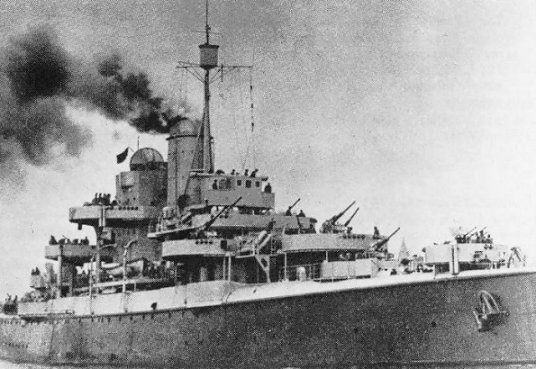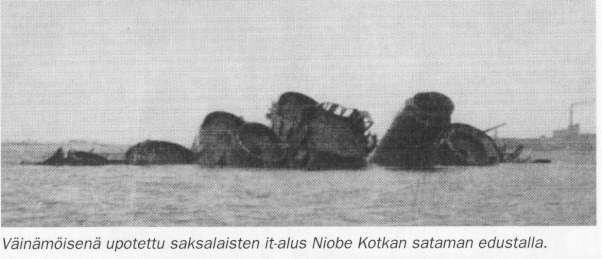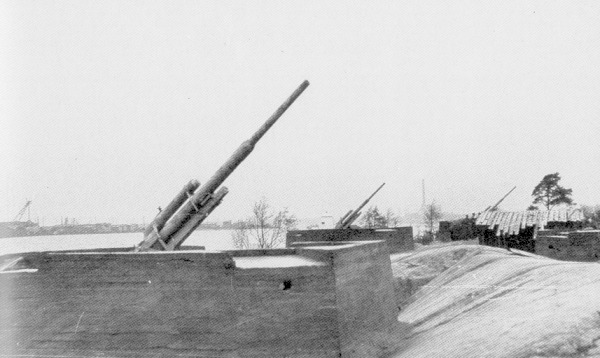|
|
|
The dramatic seabattle at Kotka, July 16th 1944 A summary based on information of AntEater, Red Star, Kossu and JAS Gripen from the IL-2 Sturmovik Board of SimHQ 1. The Story The Flakschiff Niobe (a refitted Dutch Gelderland-class coastal defence ship originally launched 1898) was sunk by the soviets near the port of Kotka, Finland, on 16 July 1944. During that time the Finnish Airforce had moved all air units away from Kymi to repell soviet's massive attack at the Karelian Isthmus. The Germans knowing that their ships based at Kotka were totally without fighter cover moved the Niobe near Kotka harbor. The soviet Baltic Fleet HQ mistakenly thought this ship to be the Finnish Navy pocket battleship "Vainamoinen" and knowing that Kotka was not protected by fighters sent an air armada of 131 planes to attack the ship. The battle between the Finnish and German AA-gunners and Russian planes took 11 minutes and resulted in the sinking of the Niobe and destruction of 9 attacking aircraft. So, not an airbattle at all, just another soviet bombing raid, this time against a military target. (Text by Kossu, 9/14/2002) 2. The Ship NIOBE
Laid up disarmed until May 1940, when she was captured by the Germans in Den Helder. Converted to floating AA-battery ( a so called "Flakschiff" ) between 1941 and 1944 ( first at C. van der Giessen & Zonen in Krimpen a/d IJssel, later in Elbing ) and renamed Niobe, she was commissioned as such on March 1 1944. She had a very short career, as she was bombed and sunk by Russian aircraft on July 16 1944 in the Finnish Gulf near Kotka. She proved to be a sturdy ship, shooting down nine aircraft and taking nine hits before sinking. Raised by the Finns in 1947, but abandoned by the Dutch government. Broken up locally. (Origin: http://leden.tref.nl/~jviss000/Default3.htm, Info by Kossu 9/14/2002) Here a bit more detailed information regarding the Niobe by AntEater 9/13/2002, SimHQ Niobe was a Kriegsmarine Ship, manned by german sailors. 3. The Planes & Pilots Some more details by JAS Gripen: I knew I had seen it but for the life of me couldn't remember where Participating ac were as follows: 28 Pe-2 from 12 Gv.BAP, Lt.Col. V.I.Rakov (strike commander) 4 A.20C Havoc from 51 MTAP, Lt.Col. I.N.Pomarenko 23 IL-2 from 47 SHAP , Lt.Col. N.G.Stepajan 30 Yak-9 from 21 IAP , Lt.Col. P.I.Pavlov 6 Yak-9 from 15 ORAP 24 LaGG-3 from 9 IAP, 11 IAP 16 La-5 from 1 Gv.IAD. Initial attack was by IL-2s (suppression?)followed by 3 separate Pe-2 diveattack waves, the last of which was a feint to draw attention from the 4 Havocs approaching low. Pe-2s scored two hits and Havocs scored the decisive two 1000kg hits below waterline sinking the ship to the bottom of the harbor. For this attack HSU was awarded to Rakov (his 2nd Gold Star), Ponomarenko, Pavlov and posthumously to Capt.Tikhomirov of the Havocs of which Soviets admitted losing the two ac that had been the last to attack. Source: Red Stars (1995) Information by JAS Gripen, 9/24/2002 Question by me: Lots of fighters joining with the bomber groups! Any information of their tasks? Surpressing the AA in the harbour area, CAP or just available fighterbombers during that time? Answer by JAS Gripen: Unfortunately no, but it is not difficult to make an educated guess based on the fighter types. LaGG-3 was very usual close escort for IL-2s while Yaks were used for topcover but in this instance the Yaks could have been Pe-2 escorts, too, as Pe-2s flew much higher due to the dive requirement (for groundtargets such as airbases the Pe-2s' dive could start from as high as 4km after an approach flight at 6 km). My bet for La-5s is a free ranging escort/sweep. Now we only need some artistic licence in form of Blue planes and an interesting "what if" mission is ready. What if Germans had allocated a staffel to defend this northern cornerstone of their "anti-Soviet navy" barrier? Say, the 12 Bf-109G6/R6 planes from the I/JG302 that had been covering Helsinki for some time before returning to Germany in May 1944? Plus a couple of FAF 109s, of course! Question by me: How many FAF fighters could possibly be there at this time and which fighter group would that have been? Answer by Kossu: Historically there were no FAF or any other fighters based at Kymi field at that time as mentioned before. Every available fighter was moved closer to the front (Karelian Isthmus) to repell the soviet onslaught. The flights that had been stationed at Kymi earlier belonged to the HLeLv
34. They were equipped first with Bf 109 G-2s and then Bf 109 G-6s (a few
G-6/R6s in the mix). Most of the FAF G-6s had Galland-Panzers and Erla-Haubes.
About a half also had the high tails. Only two G-6/AS models were delivered to
Finland, but they were never based at Kymi. Answer by JAS Gripen: What Kossu said, but perhaps I can add this: Of
LeLv34 in Kymi/Kotka it was first the 2.lentue (2nd flight/2.staffel) but in
February 16th 1944, two days after LeLv34 became HLeLv34, the 2.lentue
was transferred to re-activated HLeLv30 and the remaining 1/HLeLv34 and
3/HLeLv34 were tasked with the protection of the sector (there was to be no
2/HLeLv34 for the remainder of WW2). Projecting the strenght of a lentue at any given date is a difficult task as both the number of serviceable ac and the number of planes on organizational table fluctuated. And almost on a day-to-day basis too! Probably the exact number of combat ready planes available to 3/HLeLv34 on the day of Niobe attack could be discovered with an extended archive search. Dunno. Probably not "cost-effective" anyway, unless some "virtual HLeLv34" guy has the info. A frequent and interesting phenomen in Kotka in 1944 was the commitment of uneven numbers as Finns scrambled all available planes to protect Kotka even if they did not always fit into the rotte/schwarm principle. 5,7,11 planes meant that someone had to do without a "regular issue" wingman. Which was of no deep concern, as even to be admitted into HLeLv34's ranks the pilot had to be both experienced and talented - when 2/LeLv34 arrived in Kotka area in summer 1943 even the most junior pilot had over 100 combat missions under his belt, and the squadron remained an elite outfit to the end as 345 kills to 18 combat losses prove. Plus, of the ten top aces of Ilmavoimat six served with HLeLv34 at some point of their career. For FAF contribution I would therefore use an odd number like 3, 5, 7 or 9 in a mixture of "Bf-109G6" and "Bf-109G6 late" models, the exact number depending more on perceived need for coop balance than anything else. In other words, a design decision for *you* 4. The Anti-Aircraft defence around Kotka The town was the responsibility of radar assisted ITR2 (ilmatorjuntarykmentti 2 = flakregiment 2) and in summer -44 the regiment had 34 heavy guns (75mm and 88mm), 22 medium guns (40mm Bofors) and 34 light guns (20mm and AAMG). In addition there was Niobe, of course, and undisclosed number of other shipborne flak.
Obviously putting all this in the mission would hurt framerates, but perhaps the ratio 1:1:1 (well roughly so) for heavy/medium/light flak on the shore is useable info, the lack of 40mm guns in the mission builder notwithstanding. 5. The war in Finland, especially the soviet bombing raids Information gathered by Red Eagle When the German advance was stalled and the retreat westwards began, Soviet pressure on the northern front also started to grow. The main area of operation was the surroundings of Leningrad and the Gulf of Finland, while the main target inside Finland in 1943 was the city of Kotka, an important harbour for naval operations in the Gulf of Finland. The new dive bomber, the Petlyakov Pe-2, and the LaGG-3 and La-5 fighters, and later the Yak-9, together with the lend-lease aircraft, formed the backbone of the air fleet, which operated from bases around Leningrad, the island bases of Lavansaari, Seiskari and Kronstadt, and the Borki air base in the Oranienbaum encirclement. The Pe-2 dive bomber formations, escorted by fighters, made regular attacks on Kotka, and in addition to strengthening their anti-aircraft artillery system, the Finns had to establish a new fighter air base in Kymi and deploy their new 34th Fighter Squadron, equipped with Messerschmitt 109 G 2 fighters, there to defend Kotka. There were frequent fierce air battles over the Gulf of Finland as the Soviet formations carried out their raids and the FAF fighters attacked them from the Kymi and Suulajärvi air bases. The Soviet Air Force could easily replace the planes lost in these air battles, but the losses of pilots began to become a concern to them.22 By the beginning of 1944 the first contacts were being made about a separate peace agreement between the Soviets and the Finns. The Soviet terms were considered unacceptable in Finland, however, and so, the Soviets tried to make them see reason by sending formations from the Long Range Bomber Command (Aviatsiya Dalnego Destviya - ADD) to the air bases of Levashovo, Kasimovo and Gorskaya near Leningrad, in close proximity to the front line. These and other formations in the rear, altogether about 500 bombers, started a strategic bombing campaign and carried out three major night air raids on Helsinki in February 1944. The well coordinated barrage fire of the Helsinki anti-aircraft defence was able to repulse and deceive the main thrust of the raids, however, and the damage remained minor relative to the volume of the attacks. Out of a total of about 20,000 bombs dropped during the raids, only about 800 hit the city. Casualties amounted to 146 people killed and 356 wounded. © by RaFiGer 2002 All rights reserved.
|



